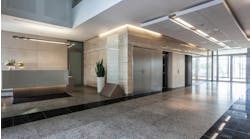The Suburban Office Park: From Cold and Sterile Cubicle Farms to Thriving Spaces for Work and Life
The death of the suburban office park has been predicted for years, but its demise never quite seems to happen. Partly because the buildings themselves are a huge investment, employers are working with building owners to reimagine these spaces to attract employees back into the suburban office post-pandemic.
When originally envisioned, suburban office parks made perfect sense for corporate headquarters. These structures could be large, set away from crowded urban centers, in the communities that many employees called home. The suburban location allowed employees to live closer to their office and decreased commute times into the city. A greenbelt was thought to provide a calming influence to cubicle-bound employees, and spacious moat-like parking lots ensured every visitor had a place for their car when they arrived.
What started as a good idea was already falling out of favor with tenants even before the pandemic forced the suburban office park to be abandoned for safety. Employees didn’t like that they had to drive 15 minutes to get a simple cup of coffee. The huge parking lots and the sterile interiors lined with drab cubicles became a stereotype for uninspired, oppressive workspaces.
In response to evolving worker expectations, property owners took note and a more mixed-use approach to suburban office parks has taken hold. These structures are built for more than just work. The modern corporate campus reflects all the facets of an employee's life. Notable suburban office parks include the corporate headquarters for Apple in Cupertino, California.
The site is located about an hour away from the densely populated downtown of San Francisco. The circular office park features a 100,000-square-foot fitness center for Apple employees, 300,000 square feet of secure research and development facilities, and 2 miles of walking and running paths for employees, underground parking plus an orchard, meadow and pond. There is child care, restaurants, and even dry cleaning so employees can focus on work but still take care of “life” outside of their job descriptions.
During the March 2016 event, Apple CEO Tim Cook said, “The workspaces and parklands [of the Apple Campus] are designed to inspire our team as well as benefit the environment. We’ve achieved one of the most energy-efficient buildings in the world, and the campus will run entirely on renewable energy.”
Cook’s statements get to one of the most important aspects of successful suburban office parks. In addition to balancing employee comfort and amenities, the facility needs to be eco-minded for employees to feel good about spending their time there. Much of the focus for attracting employees back into the office is placed on the aesthetics design, but successful spaces leverage technology to ensure smart energy use and to keep greenhouse gas emissions to a minimum.
Luckily, many of the platforms built for occupant comfort also provide the monitoring, automation and intelligence required to only use energy when people are present. Lights that activate when someone enters the room, HVAC systems that respond to outside changes in temperature to maintain a pleasant atmosphere inside, and software that analyzes building traffic patterns to draw on renewable energy whenever possible and reduce strain on local power grids.
Systems can even tell employees in the building where their colleagues are located so they can locate each other and make the most out of their time in the office. A facilities management team that understands that Fridays are typically work-from-home days for the majority of employees can make only select conference rooms and workspaces available. Directing employees to specific locations for collaboration means power can be saved throughout the rest of the building.
It's not only the newest, most cutting-edge construction that is capable of transforming into sustainability-focused facilities designed to attract employees and increase collaboration. Sensors and building controls integrated with software can give older office parks the same ability to sense, think and act to workers and outside conditions. Remote management of lighting, heating/cooling, access control, and safety can be added to existing suburban office parks to make a mixed-use approach to built spaces work for in almost any building in a commercial real estate portfolio.
Suburban office parks that have upgraded the look, feel and building systems to align with modern preferences are seeing a return on that investment. Some developers are seeing leases increase by 25% after reimagining suburban office parks for increased flexibility. New technology that gives building managers enhanced control over the spaces is the difference maker—taking an empty, useless facility and transforming it into a thriving workplace that serves occupants, reduces costs and easily demonstrates an ROI for property owners. Recent investment from commercial developers in suburban markets indicates that this style of workspace is here to stay and will continue to evolve to meet demand.


